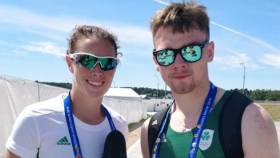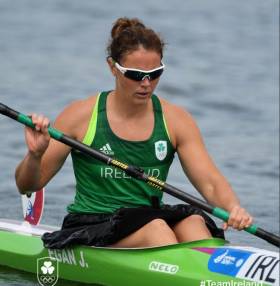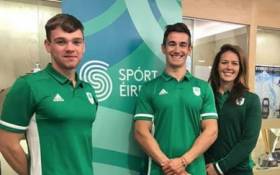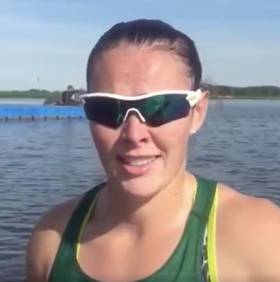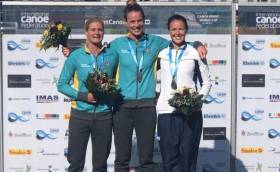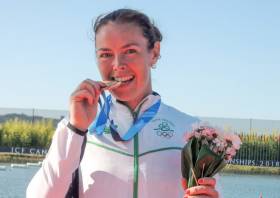Displaying items by tag: Jenny Egan
Egan One Place From Podium at European Games in Minsk
#Canoeing: Jenny Egan took fourth in the final of the K1 5,000 metres at the European Games in Minsk, Belarus today.
The race was won by local competitor Maryna Litvinchuk, who broke away early, with just Dora Bodonyi of Hungary for company. These two stayed at the head of the field and took gold and silver. Mariana Petrusova of Slovakia closed the gap to them and clung on for bronze.
Egan pushed into the lead in the chasing group and tightened the gap, but she was too far behind the top three to be able to find a podium place.
Ronan Foley finished 16th in his K1 5,000 metres final. The race was won in a sprint finish by Balint Kopasz of Hungary. He took on and beat leader Fernando Pimenta of Portugal just coming up to the line.
European Games, Minsk - Canoe Sprint (Irish interest)
Men
K1 5000 – Final: 16 Ireland (R Foley) 23:16.064
Women – K1 500 B Final (Places 10 to 18): 8 Ireland (J Egan).
K1 200 B Final (Places 10 to 18): 8 Egan.
K1 5000 – Final: 1 Belarus (M Litvinchuk) 24 min 52.258 sec, 2 Hungary (D Bodonyi) 24:53.003, 3 Slovakia (M Petrusova) 24:59.099; 4 Ireland (J Egan) 25:27.936.
Jenny Egan Eighth in Two B Finals at European Games
#Canoeing: Jenny Egan finished eighth in her two B Finals at the European Games in Minsk, Belarus. The Ireland paddler, who will go in the K1 5,000m later today, competed in the K1 500m and the K1 200m, both Olympic events.
European Games, Minsk - Canoe Sprint (Irish interest)
Women – K1 500 B Final (Places 10 to 18): 8 Ireland (J Egan).
K1 200 B Final (Places 10 to 18): 8 Egan.
Jenny Egan Qualifies for Second B Final at European Games
#Canoeing: Jenny Egan qualified for the B Final of the K1 200 metres at the European Games in Minsk. The Ireland paddler took seventh in her semi-final. “I’m really happy to make the B Final in the K1 200m, it’s a big improvement from a few weeks ago at the World Cups. It was a good race, it was quite windy out there, quite a side wind so you had to adjust your technique to cope with the conditions. But I’m happy with it and through to the B Final of the 200 tomorrow,” Egan said.
She has also qualified for the B Final of the K1 500 and will compete in the final of the K1 5,000m.
Ronan Foley was eighth in his K1 200m semi-final and missed out on a place in the finals. He is set to race in the K1 5,000m on Thursday.
#Canoeing: Jenny Egan will compete in the B Final of the women’s K1 500 metres at the European Games in Minsk, Belarus. The Ireland canoe sprint paddler finished fifth in her semi-final.
Ronan Foley produced a personal best time in his semi-final of the K1 1,000 metres, though he missed out on the finals.
Bronze for Jenny Egan at Duisburg World Cup
#Rowing: Jenny Egan had another podium finish at the canoe sprint World Cup today. Following a silver in Poznan last weekend, she took a bronze in Duisburg in her favourite event, the K1 5,000m. Two Australians took gold and silver. Ronan Foley was 15th in the men’s 5,000. Barry Watkins took sixth in the C Final of the men’s K1 1,000 and sixth in the B Final of the K1 500.
In other canoeing news, Matthew McCartney took bronze at junior level at the canoe marathon World Cup in Norway in two events: the K1 22.6 kilometre and the K1 3,400m.
Liam Jegou reached the final of the C1 at the canoe slalom European Championships in Pau, but missed out on the final.
Silver Medal for Jenny Egan at World Cup in Poznan
#Canoeing: Ireland’s Jenny Egan had another podium finish at a World Cup today. She took silver in the K1 5,000 in Poznan in Poland. Egan and Inna Hryshchun on the Ukraine broke clear of the rest of the field after the second portage. The two disputed the gold and silver placings, with Egan missing out by just over half a second.
Barry Watkins took seventh in the men’s K1 5000, while Ronan Foley took 14th.
Canoe Sprint World Cup, Poznan, Poland (Irish interest)
Saturday
Men
K1 1,000 – B Final (Places 10 to 18): 8 Barry Watkins
K1 500 – B Final (Places 10 to 18): 8 Watkins.
Women
K1 200m – Semi-Final Three (7-9 to C Final): 7 Jenny Egan. C Final (Places 19 to 27): 5 Egan
Paracanoeing: VL3 Men’s 200m – Semi-Final One: 3 Patrick O’Leary. KL3 Semi-Final: 4 O’Leary
Sunday
Men
K1 5,000 – Final: 7 Watkins, 14 Ronan Foley.
Women
K1 5,000 – Final: 1 Ukraine 25:31.548, 2 Ireland (Egan) 25:32.112, 3 Slovakia 25:51.496.
Watkins and Egan Qualify for World Cup Semi-Finals
#Canoeing: Jenny Egan and Barry Watkins qualified for semi-finals at the canoe sprint World Cup in Poznan, Poland. Egan finished fifth in her heat of the K1 200m, while Watkins matched this in the men’s K1 1,000. The paracanoeist Patrick O’Leary reached the final of the VL3 by taking third in his semi-final.
Canoe Sprint World Cup, Poznan, Poland (Irish interest)
Men
K1 1000 – Heat Two: 8 Ronan Foley. Heat Five: 5 Barry Watkins
K1 200m – Heat Two: 5 Ryan O’Connor
Women
K1 200m – Heat Six: 5 Jenny Egan
Paracanoeing: VL3 Men’s 200m – Semi-Final One: 3 Patrick O’Leary. KL3 Semi-Final: 4 O’Leary
The Olympics is not the “Holy Grail” for Jenny Egan despite her recent international success in sprint and marathon kayaking.
In a new Q&A with the Irish Examiner, the Leixlip-based paddler talks her beginnings in the sport (“Mum says I was in a boat before I was born”), the setbacks she’s faced along the way, and why her passion for kayaking outweighs any disappointments.
Last August, Egan became was the first Irish athlete to medal at the ICF Senior Canoe Sprint World Championships with a bronze — something she rates as highly as a podium finish at the Olympics.
“Of course, it would be a dream come true to qualify and race at Tokyo 2020, but I remember one Irish Olympian who pointed out that there are European and World Championships every year and you could be a world champion, but maybe not perform at the Olympic Games, as it only comes around every four years, whereas, these events are of an extremely high level and are every year.”
The Irish Examiner has much more on the story HERE.
Canoeing Honours its Stars in New Ceremony
#Canoeing: The inaugural Canoeing Ireland National Awards at the Spa Hotel in Lucan on Saturday night were a success. The prizes were spread across a range of disciplines, with young competitors to the fore. Jenny Egan and Ronan Foley were honoured in both sprint and marathon categories. One of the most popular awards on the night went to Aido Barber of canoe polo. He was named the volunteer of the year.
The keynote speaker was the president of the Olympic Federation of Ireland, Sarah Keane.
Canoeing Ireland National Awards
Freestyle: Senior Male: Dave McClure. Junior Female: Aoife Hanrahan, Junior Male: Sean Noonan.
Marathon: Sen: Jenny Egan, Barry Watkins. Jun: Ronan Foley
Polo: Sen: Rachel Molloy, Mark McCormack. Jun: Ciara Gurrhy, Zeke Wilson.
Slalom: Sen: Aisling Conlan, Liam Jegou. Jun: Maeve Martin, Tom Morley.
Sprint: Sen: Jenny Egan, Patrick O’Leary (paracanoeist). Jun: Kate McCarthy, Ronan Foley.
Surf: Sen: Aisling Griffin, Michael Barry. Jun: Megan Gamble, Jamie O’Brien
Whitewater: Darragh Clarke (junior male)
Community Impact: Kilkenny Aqua Canoe Club
Event of the Year: UCD Varsities
Team of the Year: Kilcock Demons
Volunteer of the Year: Aidrian Barber
Battling Egan Takes Fifth at Canoe Marathon World Championships
#Canoeing: Jenny Egan showed great fighting spirit, but had to settle for fifth at the canoe marathon World Championships at Vila de Prado in Portugal today. Twice she bridged a big gap to a leading group only to miss out.
She led off the start but fell back after a bad first portage. A leading group of four then took over and seemed certain to have the medals sewn up. But Egan had other ideas. At the end of the second-last lap, the sixth, she produced a remarkable sprint to join a leading group of four, only for and inefficient portage to leave her behind again. And, remarkably, the final portage was similar – a big gap closed coming into it, but off the leaders emerging from it.
Vanda Kiszli and Sara Mihalik of Hungary took first and second, with Eva Barrios of Spain taking the bronze.
Barry Watkins finished 12th in the men’s K1 race. Andrew Birkett of South Africa won an interesting race, from Adrian Boros of Hungary, with another South African, Jasper Mocke third. José Ramalho of Portugal recovered from a badly damaged boat to finish sixth.
Canoe Marathon World Championships, Vila de Prado, Portugal
Men – K1: 1 South Africa (A Birkett) 2:09.29.06; 12 Ireland (B Watkins) 2:11.45.97
Women – K1: 1 Hungary (V Kiszli) 2 hrs 6 min 16.4 sec, 2 Hungary (S Mihalik) 2:06.29.31; 5 Ireland (J Egan) 2:07.00.31.


























